Study finds that lovers perform better than random pairs in collaborative creative tasks


Love and romantic relationships are the core inspiration for countless literary and artistic works, including poems, songs, novels and movies. Over the past few decades, some psychology researchers have conducted studies aimed at better understanding the effects that love, or more specifically, passionate love, can have on people’s creativity.
Inspired by previous works, a research group at Shaanxi Normal University in Xi’an, China recently carried out a study that explored the possibility that romantically involved couples may perform better on creative tasks than other randomly paired human subjects. Their findings, published in Springer Link’s Current Psychology journal, suggest that lovers typically collaborate far better than strangers on shared creative tasks.
“Our team is committed to creativity-related research,” Haijun Duan, one of the researchers who carried out the study, told Medical Xpress. “In its early stages, most prior research on creativity focused on individuals and rarely on group-level creativity. This left a research gap in the exploration of how group creativity would be in the perspective of interpersonal interaction.”
After their birth, human beings typically form social relationships of a very different nature, including those with their parents or carers, teachers, peers and eventually lovers. Romantic relationships are known to be an essential part of most people’s adult life; thus, it is not surprising that many artists have been inspired by them and psychologists have investigated their significance.
“As the main form of adult attachment, the romantic relationship has always been a theme that many poets and writers have always praised,” Duan explained. “In the eyes of many creative artists, lovers are a great muse of inspiration. Marc Chagall once described his lover saying: ‘I had only to open my window, and blue air, love and flowers entered with her.’ Shakespeare also wrote, ‘My love will be forever in my poem.’ The impact of romantic relationship on humans has thus been the focus of numerous studies before ours.”
In the past, some psychologists gathered evidence suggesting that people who are in love tend to perform better on creative tasks. Most of them, however, recruited individual study participants who either were or were not in a romantic relationship, rather than investigating the creative collaboration between two people who are in love.
In real life, couples often collaborate and tackle problems together. In their study, therefore, Duan and his colleagues set out specifically to explore how lovers collaborated with each other on creative tasks and whether their collaboration differed from that of strangers or individuals who are not romantically involved with one another.
“Our work was inspired by several recent studies investigating the brain mechanism underlying two-person interactions,” Duan said. “For instance, researchers have found that the easier it is to integrate the ideas of partners, the more effective their collaboration will be. Compared with other types of relationships, lovers have more opportunities and advantages for cooperation. We asked ourselves, does this mean that the cooperation between lovers will be more efficient?”
After reviewing previous literature, Duan and his colleagues hypothesized that in two-person interactions, cooperation can significantly increase creativity. They then suggested that as lovers often cooperate with one another, they might also perform better on collaborative creative tasks. The researchers tested this hypothesis in an experiment where pairs of lovers and strangers were asked to collaborate on creative tasks.
“We divided participants into two combinations of unfamiliar male and female groups and heterosexual couples and asked them to complete the group creativity task-Realistic Presented Problems (RPP),” Duan said. “Prior studies have proved that this task can effectively examine individual or group creativity (e,g., those conducted by Hao et al., 2017 and Runco, et al. 2016). The reason for choosing this task is that lovers may be more likely to encounter similar problems in real life (for example, when they make an appointment to go to a concert but find that they forgot their wallet), this makes our research results more ecologically valid.”
As the participants they recruited completed a creative task, their brain activity was recorded using a technique called functional near-infrared spectroscopy (fNIRS)-based hyperscanning. This technique can be used to record cerebral cortical activity of people as they perform a series of activities.
“Just consider the following question: Can we solve the problem motionlessly in reality? Of course not,” Duan said. “We usually need to talk in the face-to-face manner in a relatively relaxed environment. Therefore, fNIRS is currently an ideal technology for studying the neural mechanisms behind human interaction.”

Duan and his colleagues used fNIRS to assess the correlation between the brain signals of the pairs of participants they recruited by calculating what is known as their inter-brain synchronization (IBS). In this context, IBS measurements essentially represent the extent to which a person puts the same effort on completing a task as their partner, which is reflected in the similarities/differences between the activation of the two participants’ brain areas.
Past findings suggest that an enhanced IBS as participants are completing collaborative tasks is reflected in an enhanced cooperation. In addition, neuroscience research has found that prefrontal and temporal-parietal junction brain regions play a crucial role in cognition-based social interactions and group creativity. In their experiment, Duan and his colleagues thus primarily examined activity in the frontal lobe and right temporal-parietal junction areas.
“An old Chinese proverb that highlights the unique link between lovers irrespective of how far they are from each other … can be approximately translated as: ‘Even when the bodies of lovers are not fluttering side by side like phoenix wings, hearts are the thread from root to tip of the magic horn,'” Duan said. “Modern science and technology allow us to observe the ‘two flying wings’ (i.e., the lovers) in conjunction and how the love between them may manifest. Two-person fNIRS technology is an excellent tool for examining the manifestation of love we hide in the heart.”
The experiments carried out by Duan and his colleagues yielded a number of interesting results. Overall, the researchers found that lovers performed better on collaborative creative tasks than pairs who were not involved in a romantic relationship. This finding could inspire other research teams to conduct studies investigating the effects of different types of interpersonal relationships on creativity (i.e., parent-child relationships, friendships, etc.).
“In East Asian countries, a low-desire lifestyle has recently appeared,” Duan said. “Many young people are losing their interest in love due to excessive pressure. Our research may provide an interesting idea to solve this problem, which can be summed up by the question: If romantic relationships can promote individual creativity and make the individuals better adapt to life, don’t you want to try having one?”
In addition to highlighting the possible benefits of romantic relationships for creative collaboration, Duan and his colleagues observed no gender differences. In other words, lovers who participated in their study performed similarly in the creative task they completed, irrespective of their gender.
In the future, the experimental methods and the group creativity paradigm used by this team of researchers could serve as a reference for other studies investigating creative collaboration. Meanwhile, Duan and his colleagues plan to carry further experiments exploring group creativity dynamics.
Source: Read Full Article